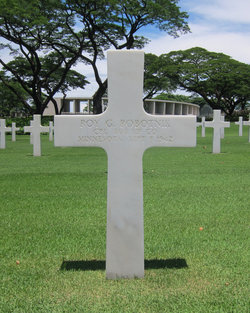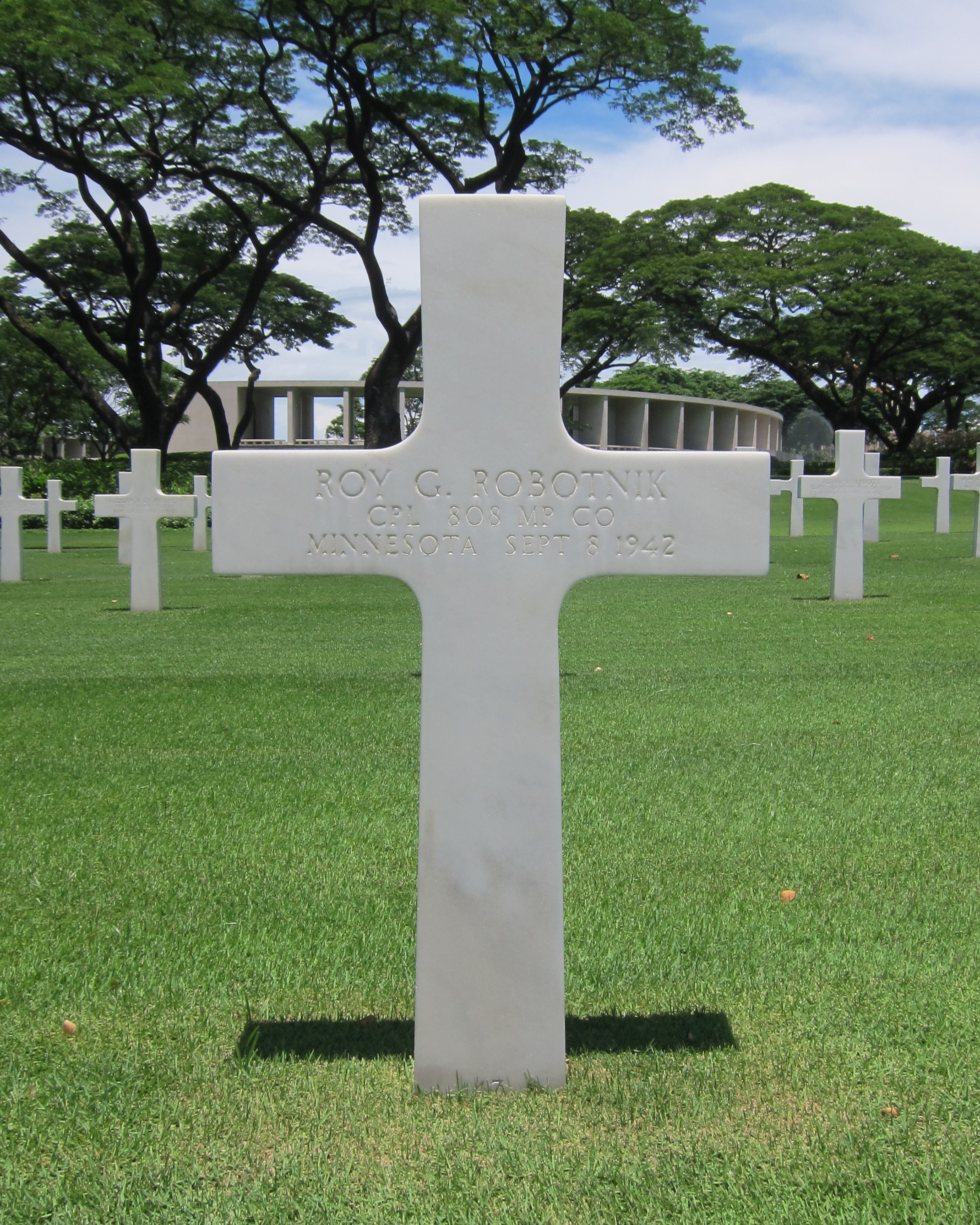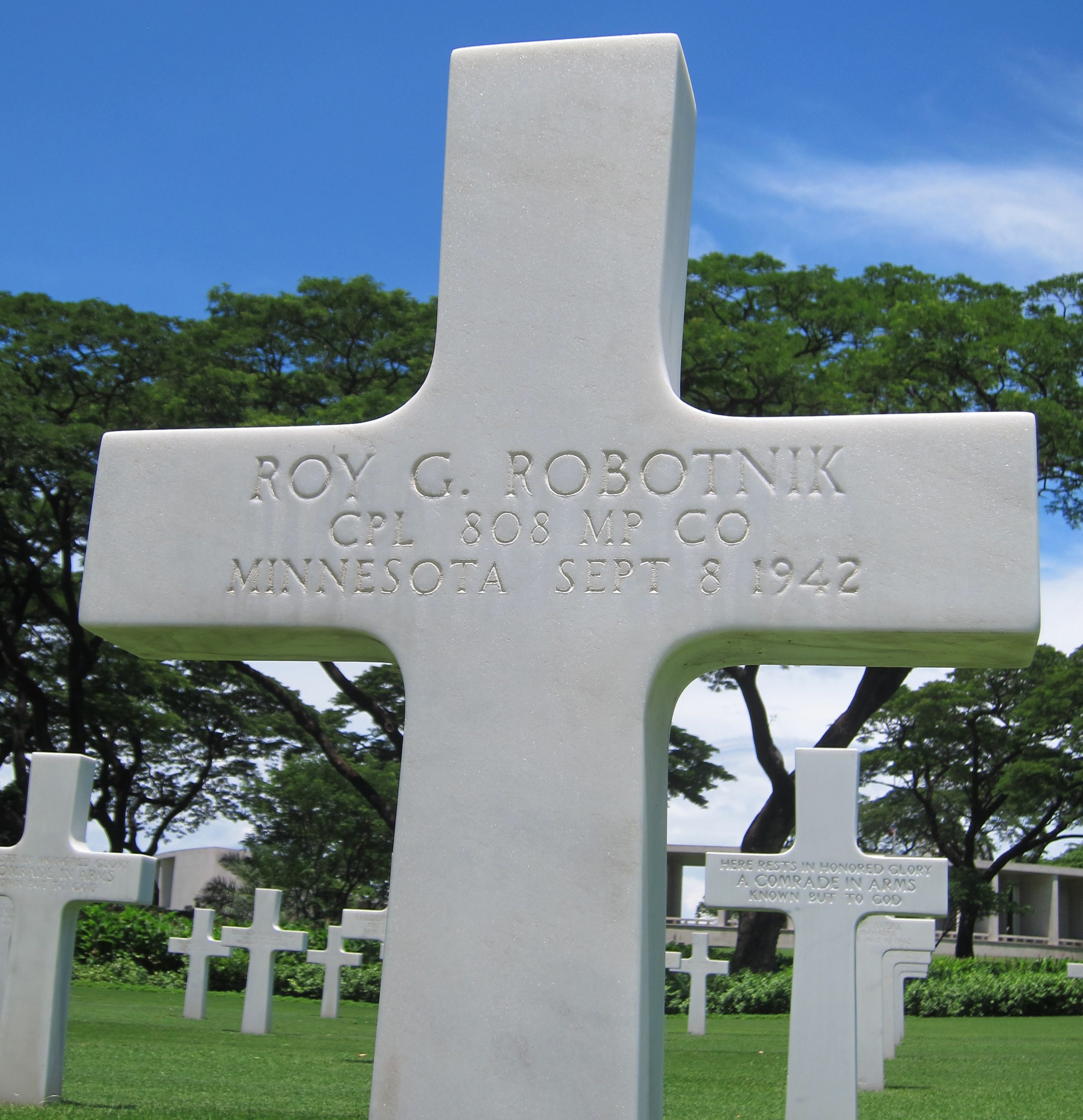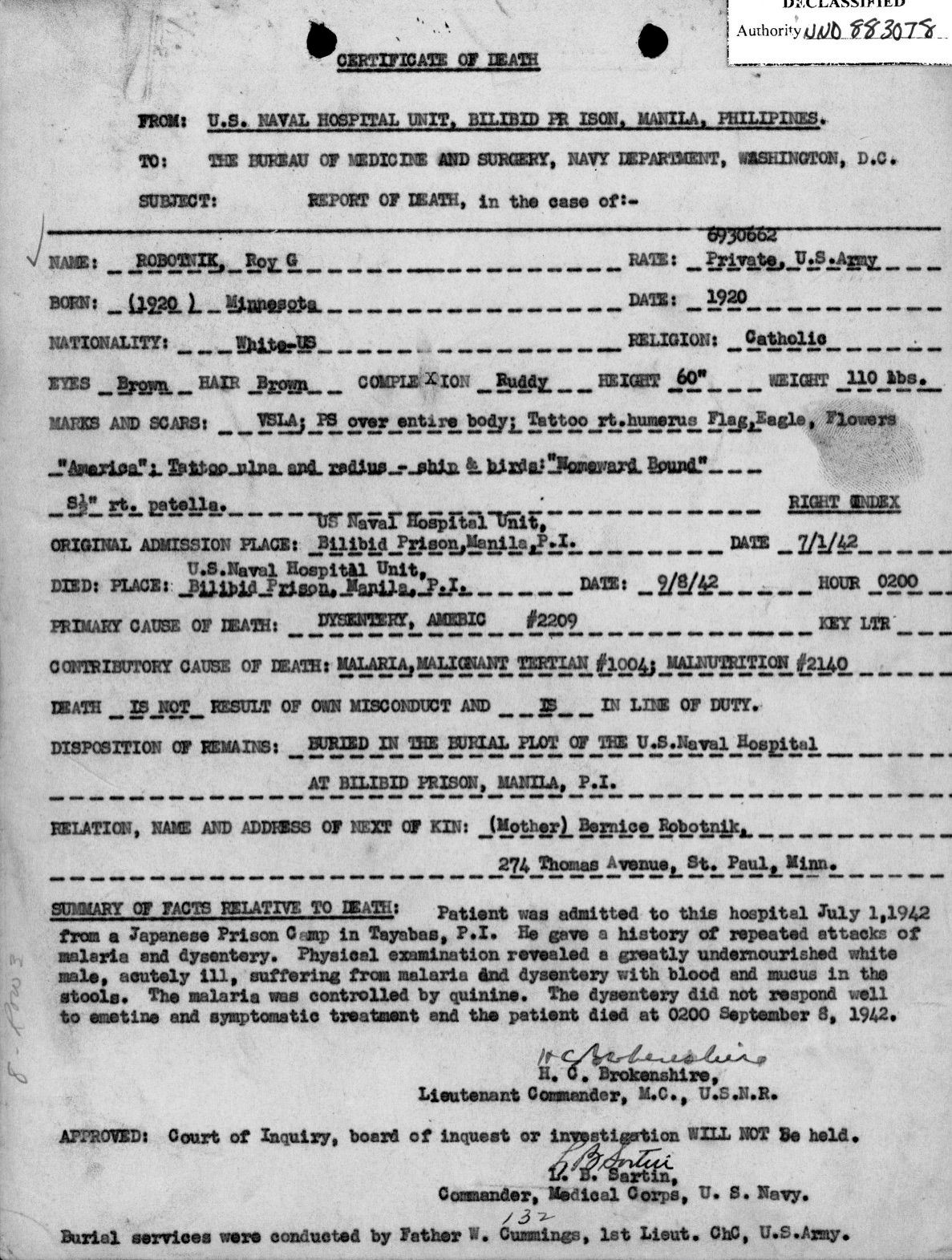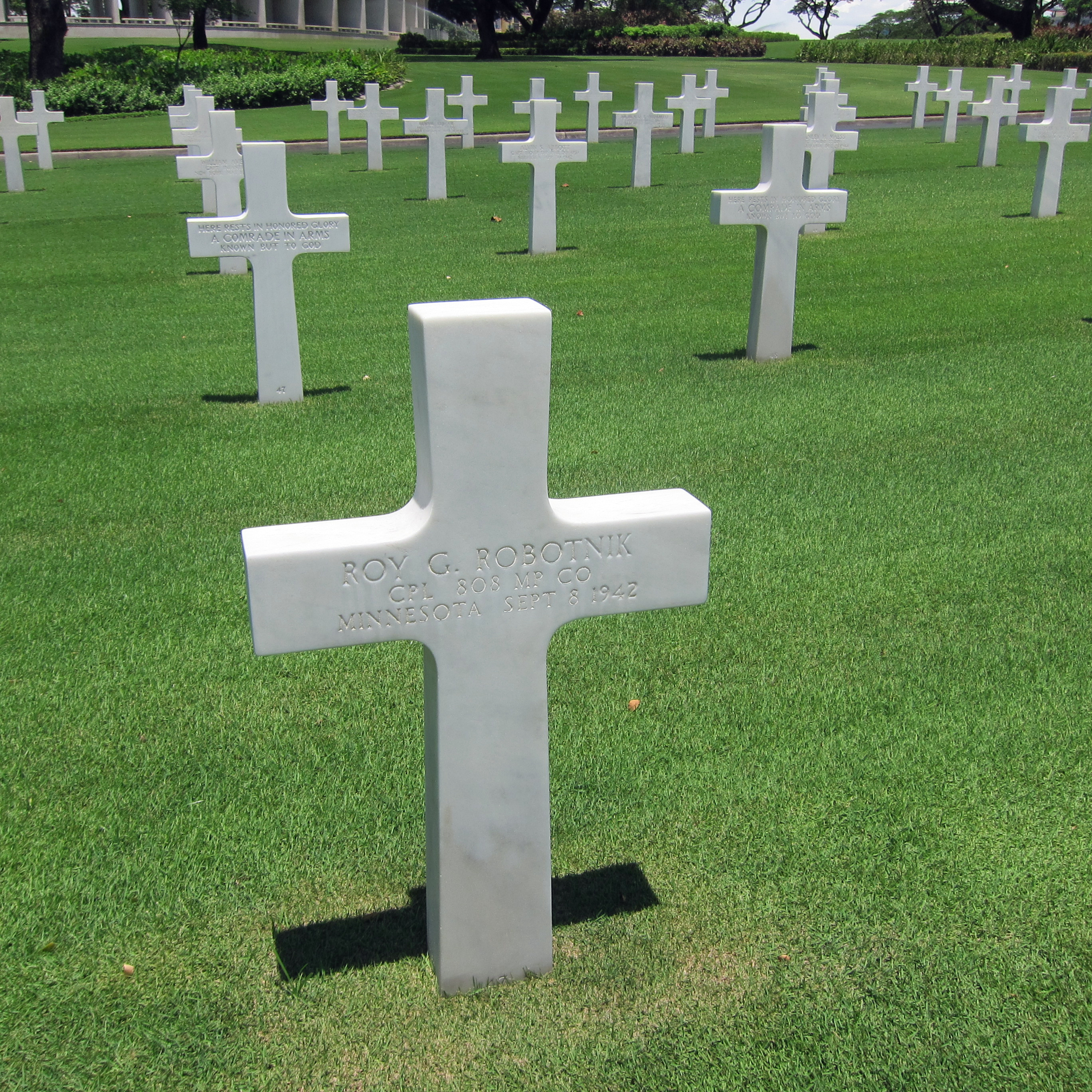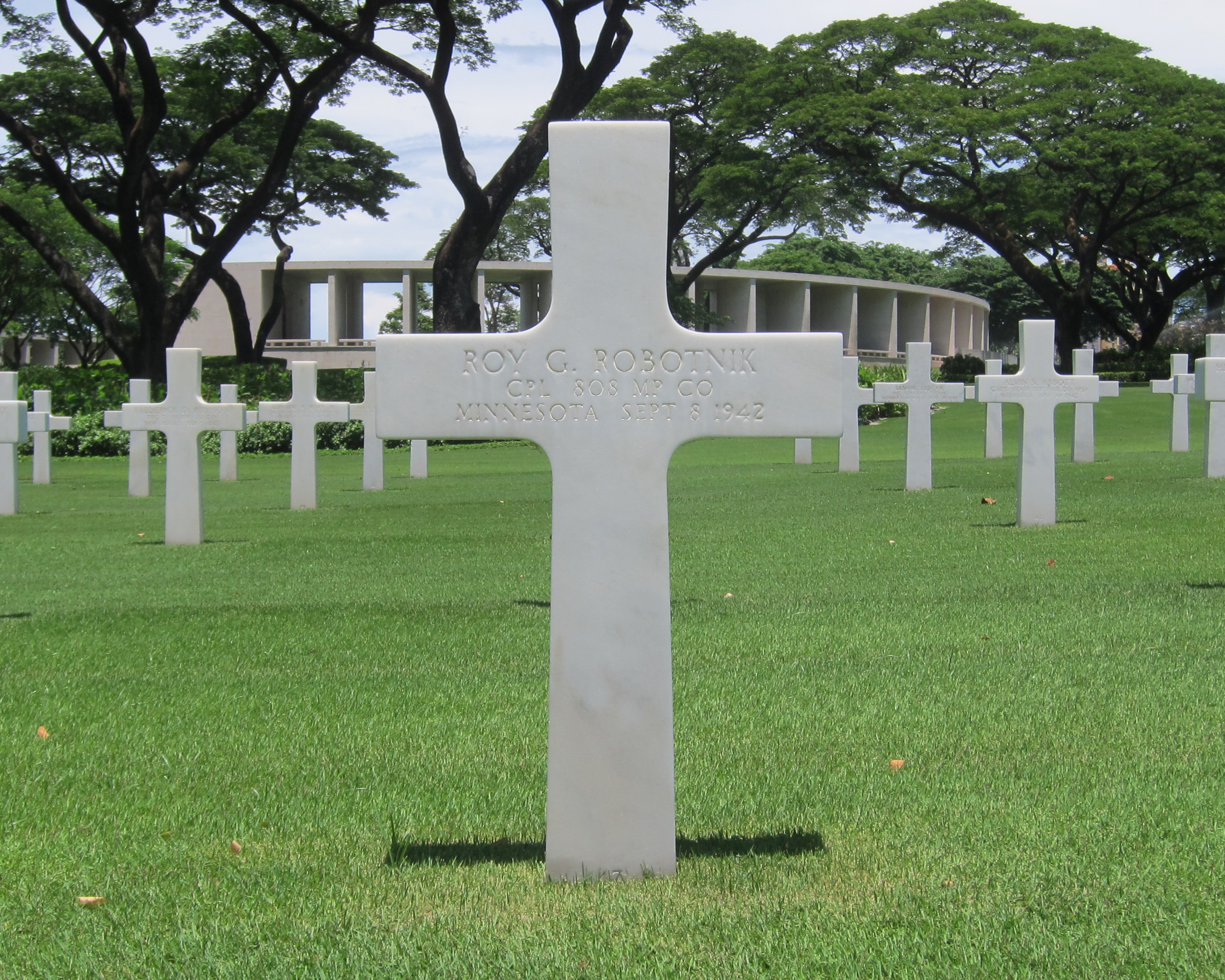Roy G. Robotnik enlisted in the U.S. Army Infantry (S/N 69306620) and was assigned to Company L, 4th Infantry.
29 January 1939 thru 30 June 1939 School for Bakers and Cooks, Fort Riley, Kansas; Company L, 4th Infantry – Private First Class Roy G. Robotnik (S/N 69306620).
Source: United States, Enlisted and Officer Muster Rolls and Rosters, 1916-1939
Private First Class Roy G. Robotnik (20 Minnesota) is found in the 1940 United States Federal Census (29 April 1940) for Camp Ord, West Spokane Township, Spokane County, Washington (sheet 14B, line 43). He had lived in St Paul, Ramsey County, Minnesota in 1935. Roy had completed 4 years of high school. He was with Company L, 4th Infantry, U.S. Army.
Roy George Robotnik (21, 07 April 1920, St Paul, Minnesota), a resident of 1715 South Hope Street (YMCA), Los Angeles, Los Angeles County, California, signed up for his World War II Draft Registration Card (Serial No. 4160, Order No. 1261-A) on 23 June 1941 in Los Angeles, Los Angeles County, California. He was unemployed, having just been discharged from the 15th Infantry, U.S. Army on 21 June 1941. Roy listed his mother, Mrs. Bernice Robotnik in St. Paul, Minnesota, as the person who would always know his address. He was described as 5' 9" in height, 172 lbs., with a light complexion, blonde hair and blue eyes. He had a tattoo on his right upper arm flag, eagle, "America".
Roy G. Robotnik (1920 Minnesota), a resident of Ramsey Minnesota, enlisted as a Private (S/N 6930662) in the U.S. Army Infantry on 15 September 1941 at Fort Snelling, Minnesota. He was single, had completed 3 years of high school and had been working in the "unskilled occupations in printing and publishing, n.e.c.". He had been an enlisted Man, Regular Army, within 3 months of discharge.
With war with Japan looming on the horizon, Roy G. Robotnik was sent to the Philippine Islands where he was assigned to D Company, 31st Infantry Regiment. Following two months of basic training at Fort McKinley, he was re-assigned to the 808th Military Police Company in Manila.
The 808th Military Police Company was one of the rare racially integrated units in the United States Army, with Americans and Filipinos serving side by side. The 808th, which had only 69 men in July of 1941, had its numbers increased to 160 by November 30th of that year.
War with Japan broke out on 08 December 1941. Their first mission after the war began was directing the dense traffic jams of retreating soldiers and refugees into the Bataan Peninsula. The 808th then became part of the Bataan Defense Force .
After enduring four months of combat, hunger, and illness, Roy G. Robotnik became a prisoner of the Japanese when the Luzon Force on Bataan was surrendered on 09 April 1942. Following the surrender, more than 75,000 American and Filipino soldiers were marched under horrific conditions to the town of San Fernando in what became known as the Bataan Death March. The prisoners were then crowded into boxcars and taken to Capas, in North Central Luzon. Upon arrival at the Capas train station, they were forced to walk the final 9 miles (14 km) to Camp O'Donnell.
In May, Roy G. Robotnik was assigned to the Tayabas Road Detail.
Tayabas Road Detail 22 May 1942 - 28 July 1942
The Tayabas Road Detail originated at Camp O'Donnell on 22 May 1942 when the Japanese took 300 POW's to go to Tabayas Province (now Quezon Province) to work on a jungle road project.
Bilibid Prison Record 5-23-42: Four (4) U.S. Army officers and two hundred ninety-six (296) enlisted men, U. S, Army, Navy and Marine Corps, arrived at this camp from Camp O'Donnell, Tarlac, P. I. , this date. The general health of this group is poor. Eighty (80) per cent of these men are suffering from malaria. Beriberi and forms of diarrhea are the other prominent complaints. Sick call and medicine dispensed for these men....The Japanese notified the Commanding Officer that the draft which arrived today would leave tomorrow morning, Severe cases sorted for retention and treatment. Eighteen (18) men are unable to be transferred. Substitutes were made for these men from well prisoners in this camp.
Bilibid Prison Record 5-24-42: The above mentioned group departed for an unknown destination at 0630 this date, (It was later learned that this draft was sent to Tayabas, P.I. , as a work detail (road gang). Source: Kentner's Journal Bilibid Prison, Manila, P.I. from 12-8-41 to 2-5-45 by Pharmacist Mate, Robert W. Kentner, page 23.
Three officers and 297 enlisted men traveled by truck to Pasay Elementary School, on the southern side of Manila. Some members of the Canacao Naval Hospital from Cavite were quartered there with patients injured during the bombing of the Cavite Naval Station early in December 1941. Medical personnel at Pasay Elementary School provided care to the most seriously sick of the traveling group and arranged for replacements for the five most seriously ill persons on the detail. The POW's left Pasay School at 0630 24 May 1942 by trucks to Tabayas, stopping overnight at an abandoned sugar mill somewhere in Batangas Province. The men arrived at the work location following a long hike from the main road in the early morning hours of 28 May 1942, leaving one person dead along the trail." They started out on trucks and then they boarded railroad flatcars. They traveled three days altogether and then they were told to start walking. Many of the men were ill with fevers and dysentery, but they walked fifteen miles up and down the hills of jungle until they stopped after passing a bridge. The guards showed them a flat point bar of rocks. In back of the rocks, the dark jungle loomed. The area provided no cover for the men, and their beds were the rocks themselves with no protection from the monsoons that threatened the area. The men dug out the rocks and slept in the mud, and the mosquitoes soon attacked them. The next day they started their job of cutting the jungle down and building a road with the wheelbarrows, picks and shovels the Japanese gave them. The men ate what they carried in with them, rice and corned beef hash. They used a rusty old wheelbarrow covered with concrete to cook their food. The work of cutting the huge roots and trying to move the wheelbarrows through the muck proved harsh, and as the men became sicker and sicker, less of them went out each day. The men started dying.....Source: Tears in the Darkness, by Michael Norman and Elizabeth Norman.
Those that were too sick to work were taken to Bilibid Prison in Manila.
Bilibid Prison Record 6-19-42: Thirty-five (35) patients admitted to the hospital from a Japanese work detail (road gang) in Tayabas, P.I., at 1700 this date. All of these men were acutely ill. Source: Kentner's Journal Bilibid Prison, Manila, P.I. from 12-8-41 to 2-5-45 by Pharmacist Mate, Robert W. Kentner, page 28.
Bilibid Prison Record 7-1-42: Thirty-two (32) patients admitted from a Japanese work detail (road gang) in Tayahas, P.I., this date. Source: Kentner's Journal Bilibid Prison, Manila, P.I. from 12-8-41 to 2-5-45 by Pharmacist Mate, Robert W. Kentner, page 30.
Roy G. Robotnik was one of those 32 prisoners brought to Bilibid. He was admitted to the U.S. Naval Hospital Unit, Bilibid Prison, Manila, Philippines on 01 July 1942. He had a history of repeated attacks of dysentery and malaria. Roy was "greatly undernourished". Corporal Roy G. Robotnik died at 2 am on 08 September 1942 of amebic dysentery in the hospital. Contributing causes of death were malaria and malnutrition.
Bilibid Prison Record 9-8-42: ROBOTNIK, Roy G., Private, U.S. Army ASN: 6930662, died at 2000 this date. Cause of death: Dysentery, amebic. Buried in hospital plot, row three, grave eight. Source: Kentner's Journal Bilibid Prison, Manila, P.I. from 12-8-41 to 2-5-45 by Pharmacist Mate, Robert W. Kentner, page 35.
Roy was buried in the Bilibid Prison hospital cemetery – Row 3, Grave 8. After the war his remains were disinterred and brought to 7747 USAF Cemetery, Manila #2, Philippine Islands where they were reburied on 13 June 1945 – Block 1, Row 14, Grave 1768, (D-D No. 10291). The deceased in Manila #2 (over 11,000 American soldiers) rested there until their removal to the American Graves Registration Service Manila Mausoleum in the summer of 1948. From there, according to the wishes of his next of kin (father, Mr. August R. Robotnik), Corporal Roy George Robotnik was buried in his final resting place in the Manila American Cemetery – Plot A, Row 6, Grave 47.
According to the National Archives, 111 members of the 808th (out of 160) were captured by the Japanese, and at least 91 died.
Roy G. Robotnik enlisted in the U.S. Army Infantry (S/N 69306620) and was assigned to Company L, 4th Infantry.
29 January 1939 thru 30 June 1939 School for Bakers and Cooks, Fort Riley, Kansas; Company L, 4th Infantry – Private First Class Roy G. Robotnik (S/N 69306620).
Source: United States, Enlisted and Officer Muster Rolls and Rosters, 1916-1939
Private First Class Roy G. Robotnik (20 Minnesota) is found in the 1940 United States Federal Census (29 April 1940) for Camp Ord, West Spokane Township, Spokane County, Washington (sheet 14B, line 43). He had lived in St Paul, Ramsey County, Minnesota in 1935. Roy had completed 4 years of high school. He was with Company L, 4th Infantry, U.S. Army.
Roy George Robotnik (21, 07 April 1920, St Paul, Minnesota), a resident of 1715 South Hope Street (YMCA), Los Angeles, Los Angeles County, California, signed up for his World War II Draft Registration Card (Serial No. 4160, Order No. 1261-A) on 23 June 1941 in Los Angeles, Los Angeles County, California. He was unemployed, having just been discharged from the 15th Infantry, U.S. Army on 21 June 1941. Roy listed his mother, Mrs. Bernice Robotnik in St. Paul, Minnesota, as the person who would always know his address. He was described as 5' 9" in height, 172 lbs., with a light complexion, blonde hair and blue eyes. He had a tattoo on his right upper arm flag, eagle, "America".
Roy G. Robotnik (1920 Minnesota), a resident of Ramsey Minnesota, enlisted as a Private (S/N 6930662) in the U.S. Army Infantry on 15 September 1941 at Fort Snelling, Minnesota. He was single, had completed 3 years of high school and had been working in the "unskilled occupations in printing and publishing, n.e.c.". He had been an enlisted Man, Regular Army, within 3 months of discharge.
With war with Japan looming on the horizon, Roy G. Robotnik was sent to the Philippine Islands where he was assigned to D Company, 31st Infantry Regiment. Following two months of basic training at Fort McKinley, he was re-assigned to the 808th Military Police Company in Manila.
The 808th Military Police Company was one of the rare racially integrated units in the United States Army, with Americans and Filipinos serving side by side. The 808th, which had only 69 men in July of 1941, had its numbers increased to 160 by November 30th of that year.
War with Japan broke out on 08 December 1941. Their first mission after the war began was directing the dense traffic jams of retreating soldiers and refugees into the Bataan Peninsula. The 808th then became part of the Bataan Defense Force .
After enduring four months of combat, hunger, and illness, Roy G. Robotnik became a prisoner of the Japanese when the Luzon Force on Bataan was surrendered on 09 April 1942. Following the surrender, more than 75,000 American and Filipino soldiers were marched under horrific conditions to the town of San Fernando in what became known as the Bataan Death March. The prisoners were then crowded into boxcars and taken to Capas, in North Central Luzon. Upon arrival at the Capas train station, they were forced to walk the final 9 miles (14 km) to Camp O'Donnell.
In May, Roy G. Robotnik was assigned to the Tayabas Road Detail.
Tayabas Road Detail 22 May 1942 - 28 July 1942
The Tayabas Road Detail originated at Camp O'Donnell on 22 May 1942 when the Japanese took 300 POW's to go to Tabayas Province (now Quezon Province) to work on a jungle road project.
Bilibid Prison Record 5-23-42: Four (4) U.S. Army officers and two hundred ninety-six (296) enlisted men, U. S, Army, Navy and Marine Corps, arrived at this camp from Camp O'Donnell, Tarlac, P. I. , this date. The general health of this group is poor. Eighty (80) per cent of these men are suffering from malaria. Beriberi and forms of diarrhea are the other prominent complaints. Sick call and medicine dispensed for these men....The Japanese notified the Commanding Officer that the draft which arrived today would leave tomorrow morning, Severe cases sorted for retention and treatment. Eighteen (18) men are unable to be transferred. Substitutes were made for these men from well prisoners in this camp.
Bilibid Prison Record 5-24-42: The above mentioned group departed for an unknown destination at 0630 this date, (It was later learned that this draft was sent to Tayabas, P.I. , as a work detail (road gang). Source: Kentner's Journal Bilibid Prison, Manila, P.I. from 12-8-41 to 2-5-45 by Pharmacist Mate, Robert W. Kentner, page 23.
Three officers and 297 enlisted men traveled by truck to Pasay Elementary School, on the southern side of Manila. Some members of the Canacao Naval Hospital from Cavite were quartered there with patients injured during the bombing of the Cavite Naval Station early in December 1941. Medical personnel at Pasay Elementary School provided care to the most seriously sick of the traveling group and arranged for replacements for the five most seriously ill persons on the detail. The POW's left Pasay School at 0630 24 May 1942 by trucks to Tabayas, stopping overnight at an abandoned sugar mill somewhere in Batangas Province. The men arrived at the work location following a long hike from the main road in the early morning hours of 28 May 1942, leaving one person dead along the trail." They started out on trucks and then they boarded railroad flatcars. They traveled three days altogether and then they were told to start walking. Many of the men were ill with fevers and dysentery, but they walked fifteen miles up and down the hills of jungle until they stopped after passing a bridge. The guards showed them a flat point bar of rocks. In back of the rocks, the dark jungle loomed. The area provided no cover for the men, and their beds were the rocks themselves with no protection from the monsoons that threatened the area. The men dug out the rocks and slept in the mud, and the mosquitoes soon attacked them. The next day they started their job of cutting the jungle down and building a road with the wheelbarrows, picks and shovels the Japanese gave them. The men ate what they carried in with them, rice and corned beef hash. They used a rusty old wheelbarrow covered with concrete to cook their food. The work of cutting the huge roots and trying to move the wheelbarrows through the muck proved harsh, and as the men became sicker and sicker, less of them went out each day. The men started dying.....Source: Tears in the Darkness, by Michael Norman and Elizabeth Norman.
Those that were too sick to work were taken to Bilibid Prison in Manila.
Bilibid Prison Record 6-19-42: Thirty-five (35) patients admitted to the hospital from a Japanese work detail (road gang) in Tayabas, P.I., at 1700 this date. All of these men were acutely ill. Source: Kentner's Journal Bilibid Prison, Manila, P.I. from 12-8-41 to 2-5-45 by Pharmacist Mate, Robert W. Kentner, page 28.
Bilibid Prison Record 7-1-42: Thirty-two (32) patients admitted from a Japanese work detail (road gang) in Tayahas, P.I., this date. Source: Kentner's Journal Bilibid Prison, Manila, P.I. from 12-8-41 to 2-5-45 by Pharmacist Mate, Robert W. Kentner, page 30.
Roy G. Robotnik was one of those 32 prisoners brought to Bilibid. He was admitted to the U.S. Naval Hospital Unit, Bilibid Prison, Manila, Philippines on 01 July 1942. He had a history of repeated attacks of dysentery and malaria. Roy was "greatly undernourished". Corporal Roy G. Robotnik died at 2 am on 08 September 1942 of amebic dysentery in the hospital. Contributing causes of death were malaria and malnutrition.
Bilibid Prison Record 9-8-42: ROBOTNIK, Roy G., Private, U.S. Army ASN: 6930662, died at 2000 this date. Cause of death: Dysentery, amebic. Buried in hospital plot, row three, grave eight. Source: Kentner's Journal Bilibid Prison, Manila, P.I. from 12-8-41 to 2-5-45 by Pharmacist Mate, Robert W. Kentner, page 35.
Roy was buried in the Bilibid Prison hospital cemetery – Row 3, Grave 8. After the war his remains were disinterred and brought to 7747 USAF Cemetery, Manila #2, Philippine Islands where they were reburied on 13 June 1945 – Block 1, Row 14, Grave 1768, (D-D No. 10291). The deceased in Manila #2 (over 11,000 American soldiers) rested there until their removal to the American Graves Registration Service Manila Mausoleum in the summer of 1948. From there, according to the wishes of his next of kin (father, Mr. August R. Robotnik), Corporal Roy George Robotnik was buried in his final resting place in the Manila American Cemetery – Plot A, Row 6, Grave 47.
According to the National Archives, 111 members of the 808th (out of 160) were captured by the Japanese, and at least 91 died.
Gravesite Details
Entered the service from Minnesota.
Sponsored by Ancestry
Advertisement
Advertisement
